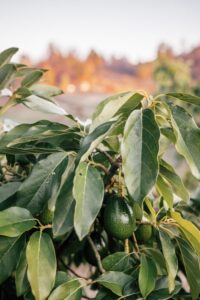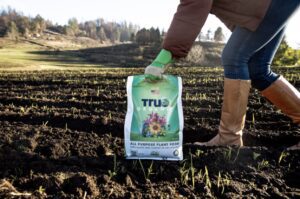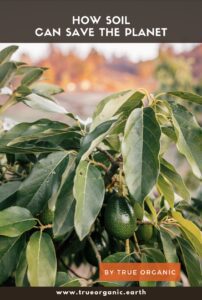September 2, 2021
How Soil Can Save The Planet
Beautiful and tasty!
Here at True Organic, we’re obsessed with soil. And it’s not just because healthy soil is the backbone of the farms and food that sustain us. Healthy soil is also one of the keys to sustaining and restoring our planet and atmosphere.
Replenishing our soil plays a vital role in sequestering carbon, improving water retention, and enhancing soil fertility. It’s a mission that sits at the heart of our company.
Let’s take a closer look at the role soil plays in carbon sequestration.
Soil + Carbon = Happy Plants
Dirt is considered simply mineral matter, like sand and bits of rock. (It’s not alive.)
Soil contains some of that mineral matter, plus a lot of organic (living) matter. Bacteria, fungi, earthworms, and all sorts of other living organisms live and thrive in soil.
Plants need to take in carbon to sustain their own energy, and soil needs carbon as well. More specifically, all those microbes that live in soil need carbon!
It’s a symbiotic relationship: the happier those soil microorganisms are, the happier plants can be. As happy plants convert carbon dioxide (CO2) and water (H2O), bacteria and fungi in soil feast on carbon and other macronutrients for their own livelihood, too.
Let’s Talk About CO2
Carbon dioxide is the most commonly produced greenhouse gas (“greenhouse” means that it lingers in Earth’s atmosphere and soaks up infrared radiation, trapping heat). While carbon dioxide is and always has been a naturally produced part of life existing on our lush planet, some types of human activity increase the amount of carbon dioxide in the atmosphere.
Right now, there is a lot more carbon dioxide in the atmosphere than there should be for sustained, thriving life on Earth as it’s meant to be.
Other gases, too, like methane and ozone, have become too plentiful in Earth’s atmosphere. This imbalance of greenhouse gases is harmful to our planet and for us humans.
But it’s particularly that CO2 that we most urgently need to take care of. That’s why carbon sequestration is so important, and why agriculture has such a big role to play.
It’s why we started True Organic.
What Is Carbon Sequestration?
It seems like magic: drawing carbon dioxide out of the atmosphere and storing it in the ground, where it’s actually an essential part of life. But it’s real! And nature actually does it all on its own.
The process of capturing carbon from the atmosphere and placing it into soil is a natural part of plants’ photosynthesis process. It’s happening all the time, all around us. Grass does it, trees do it, even the curly kale and tomato vines in your garden do it.
Biologic carbon sequestration refers to atmospheric carbon getting taken in by plants and deposited back into soil (and sometimes aquatic and geological environments).
To understand how that works, let’s take a stroll through the garden.
Photosynthesis
Thinking back to Earth Sciences and Biology classes at school, photosynthesis is the way plants sustain themselves. It’s how they get nutrients and nourish their cells. With the help of sunlight and minerals from the soil, plants have the ability to break down CO2 and H2O to create their own ”food”.
Under our feet when we’re taking a stroll on green grass, above our heads when we’re hiking through a canopy of trees—all those plants are happily taking in carbon dioxide through their leaves, soaking up sun and water, and turning that into fuel to stay alive.
So what happens to carbon after plants absorb it in the form of CO2?

Carbon sequestration refers to the process that puts that carbon back into the soil, where it’s stored.
Agriculture Can Make a Difference
Ready for a dose of hope?
Farming and gardening have massively powerful potential to remove excess carbon from the atmosphere and put it back in the ground.
It requires thoughtful, soil-friendly techniques that help plants thrive in an organic environment while rebuilding soil’s natural potential.
Sustainable, regenerative, organic farming methods encourage and enhance carbon sequestration, and those types of farming practices are booming. Reforestation, too, has been shown to be incredibly effective for carbon sequestration.
What’s more, those organic methods increase yield over time, produce super healthy harvests, and support biodiversity.
Carbon Sequestration In Your Home Garden
While nature does carbon sequestration all on its own, we can help it along. The more plants we tend (including farms, forests, grasslands, native plant sanctuaries, and gardens), the more carbon your plants will eat.
Yes, you can even help capture carbon and nurture soil at home. You don’t need a huge farm or forest to join the movement to rebuild soil to its carbon-capturing, plant-supporting true nature.
Look more into the wonders of regenerative farming and home gardening in our National Soil Health Day blog.
It’s Our TRUE Mission
True Organic was founded with all of this in mind. We set forth on a mission to revitalize soil’s massive potential to support thriving life in all its forms.
We began by providing organic, soil-rebuilding fertilizers to large-scale agricultural enterprises. The big picture is important; we help some of the biggest growers in the country operate with soil health at the forefront.
But change happens on the individual level, too, and we believe it’s vital to support home gardeners make a difference.
Our mission now is to help everyone, from big farmers to community garden tenders, learn about what soil and plants need to thrive—and help you do that every day.
Show us your True Organic Plants
#GrowWithTrue
www.trueorganic.earth




